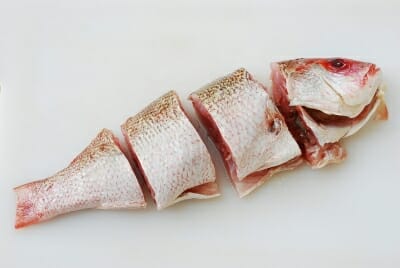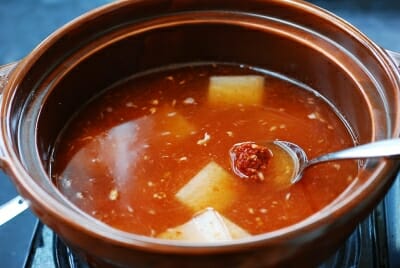
One of the classic Korean stew dishes is this spicy fish stew, called maeuntang (매운탕). In Korea, maeuntang is made with all sorts of fish, including freshwater ones. For this recipe, I made it with a red snapper (domi, 도미), which has a firm, white flesh with a mildly sweet and nutty flavor.
Maeuntang is a general term for spicy stews, but it’s commonly used to refer to spicy fish stews. “Maeun” means spicy. “Tang” is a term used for certain types of soup (guk), such as seolleongtang and galbitang, or sometimes for certain types of stew (jjigae) dishes, such as gamjatang and maeuntang. Traditionally, the term “tang” was used for elaborate soups or stews, but it’s loosely used in modern days.
For this stew, you can use any firm, white flesh fish. Cod fish (daegu, 대구), monkfish (agu, 아구), black rockfish (wooreok, 우럭) and yellow croaker (jogi, 조기) are some of the common ones.
We normally use a whole fish cut up for this dish, including the head and bones. You can ask the fishmonger to clean and cut it for you. If preferred, use fish fillets, but the head and bones are great for flavoring the stew. Be sure the fish you buy is absolutely fresh!
In Korea, a great number of restaurants specializing in seafood have an aquarium(s) in house, where live fish are kept. This reminds me of maeuntang we had in Tongyeoung last fall, a southern coastal city of Korea. We arrived late and very hungry. After being turned away by several restaurants which were closing, we were invited in by a nice lady at a small restaurant. She made us maeuntang with a couple of fish she caught from her fish tank outside. She also allowed me in her kitchen to watch her making the stew. Her maeuntang was a memorable one!
As with most of Korean stews (jjigae), anchovy broth is used for this dish to add depth to the stew. I like to throw in some clams (or shrimp) to add another layer of flavor to the broth.
Finally, adjust the spicy level to your taste by reducing or increasing gochugaru. For a mild tasting fish stew, see my daegu tang recipe.
For more Korean cooking inspirations, follow along on YouTube, Pinterest, Twitter, Facebook, and Instagram.

Ingredients
- 1 whole snapper about 1-1/4 pounds
- 3 little neck clams or any other small clams
- 6 ounces mu, (무, Korean radish) 1 inch disk
- 6 ounces tofu
- 3 ounces zucchini
- 1 scallion
- 1 ounce ssukgat crown daisy or watercress
Seasoning:
- 1-1/2 tablespoons gochugaru Korean red chili pepper flakes
- 1 teaspoon gochujang Korean red chili pepper paste
- 1 teaspoon doenjang Korean fermented soybean paste
- 1 tablespoon fish sauce or soup soy sauce
- 1 tablespoon garlic
- 1 teaspoon ginger
Other:
- 3 cups anchovy broth or water
- salt to taste about 1 teaspoon
- pepper to taste
Instructions
- Clean the fish, remove guts, scales, and fins, if not already done by the fishmonger. Rinse and scrub the clams. Place the clams in salted water (1 tablespoon of salt in 2 to 3 cups of water) for 30 minutes or longer to get the clams to spit out the sand.
- Clean the vegetables. Cut the radish into bite sizes. Thinly slice the scallions and the pepper. Cut the tofu into 1/2-inch thick small pieces.
- In a small bowl, combine all the seasoning ingredients and mix well.
- Add the broth to a medium size pot along with the radish and the seasoning mix. Bring it to a boil over high heat. Cook until the radish turns soft, about 3 minutes.
- Drop in the fish, clams and tofu. When it comes to a boil again, reduce the heat to medium. Cook until the clams are open and the fish is almost cooked through, about 5 minutes. (Do not overcook. The fish will continue to cook in the boiling hot broth while being served and eaten.)
- Add the zucchini, enoki mushrooms, and scallions, and boil for a minute or two. Place the watercress or crown daisy leaves on top. Turn the heat off. Serve piping hot with the optional lemon slice on top.
































Jane Park says
Yum! Really delicious. Thank you! Made just as you said, but used cod instead of the red snapper
Stacy J says
Perfect recipe. I was worried because red snapper is expensive but after trying many other recipes, I feel confident buying ingredients and cooking with your recipes. Thank you so much!
Hyosun says
Thank you! Glad it came out perfectly for you.
Ashley says
Made this tonight with yellow croaker and it was absolutely delicious! Thank you for sharing. Love your recipes so much!
Julie says
It says this recipe if for 39 servings it that correct? I only wanna try to make it for 4 servings.
Hyosun says
Wow how did that happen? I recently switched a blog theme and some things got messed up. Maybe this is related to that too. Fixed it! I can only put one number but this can be 2 to 3 servings. Maybe 4 small servings.
Maya Jensen says
Hi, I would like to make this recipe but what is “6 ounces mu 1 inch disk”? Thank you
Hyosun says
It’s Korean radish, a variety of white radish.
Yawar says
Fantastic!
I was searching for it finally!
Thanks
Hyosun says
Great! Hope you enjoy it.
Rarakitchen says
Cheers hyosun you are the best korean food blogger, anyway did you ever try indonesian food???
Hyosun says
Thanks! Yes I have.
Ermin Fei says
Hello Hyosun ssi.. i would like to ask you, when should we put in the zuchinni? And please note that there is no enoki mushroom in your ingredient list. Thank you ^^.
Hyosun says
Oops thank you for letting me know. Fixed it.
Maggie says
I still don’t see where it says to add zucchini but I added it with the fish and tofu
Hyosun says
Oh so sorry. I thought I did. Now added.
Ermin Fei says
Still no enoki mushroom on the ingredient list 😅
Erin McBride says
Hello Hyosun, you have a fabulous website which I found quite by accident. I am trying to find a particular Korean seafood recipe and I think I may have found it here. For may years I was a fisheries observer in and around the Southern Ocean, and many of my voyages were on Korean & Japanese trawlers. Always, the food on these vessels was superb but as the cooks seldom spoke english I never managed to get any of those recipes. I fondly remember my favourite dish, which was a seafood stew with tofu and a chilli sort of gravy, but the fish was poached, not fried nor grilled, and was so moist and yummy and tender. Today I bought a couple of ponds of fresh Ling and want to recreate that dish. Your Domi Maeuntang recipe looks to be it, but I cannot remember having shrimps nor shellfish with it? Is there a similar recipe that doesn’t include these? Many thanks
Erin McBride
Hyosun says
Hi Erin – Yes it sounds like it was maeuntang. Please simply omit shellfish if preferred. I use it to add another layer to the broth but it can be omitted. Koreans make maeuntang with or without shellfish. It’s a matter of preference or sometimes depending on what’s available. I know nothing like a stew made with fish fresh from the ocean, but hope this recipe is close enough. Enjoy!